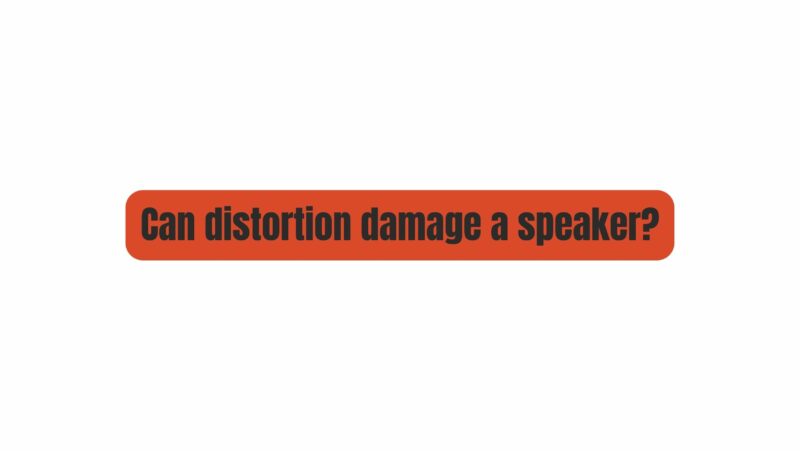Speakers are essential components of our daily lives, whether we’re enjoying music, watching a movie, or participating in a conference call. These electronic devices convert electrical signals into sound waves, allowing us to hear the audio content we love. However, one question that often arises among audio enthusiasts and casual users alike is whether distortion can damage a speaker. In this article, we will delve deep into the world of speakers, examining what distortion is, the different types of distortion, and the potential consequences it may have on speaker health.
Understanding Distortion
Before we can explore the impact of distortion on speakers, it’s crucial to understand what distortion is and how it occurs. Distortion in audio refers to any alteration or deviation from the original signal. It results in the production of unwanted harmonics or frequencies that were not present in the original audio source. Distortion can manifest in various ways, each having its own unique characteristics. Here are some common types of distortion:
- Clipping Distortion: This type of distortion occurs when the amplifier or speaker driver is pushed beyond its limits. When the signal’s amplitude exceeds the maximum capacity of the system, it gets “clipped,” causing the waveform to flatten or clip. This results in a harsh, grating sound and is often associated with damaged equipment.
- Harmonic Distortion: Harmonic distortion involves the creation of additional frequencies that are integer multiples of the original signal’s frequency. These harmonics can make the audio sound unnatural or unpleasant, affecting the overall listening experience.
- Intermodulation Distortion: Intermodulation distortion arises when two or more frequencies interact within a speaker or amplifier, creating sum and difference frequencies. This type of distortion can produce unwanted sounds and artifacts in the audio.
The Impact of Distortion on Speakers
Now that we have a basic understanding of distortion, let’s explore how it can affect speakers. To comprehend this, we need to look at the speaker’s components and how they handle different types of distortion.
- Speaker Drivers: Speakers consist of various components, including the diaphragm, voice coil, magnet, and surround. When distortion is introduced into the system, the voice coil, in particular, is subjected to increased stress. Clipping distortion, where the signal exceeds the speaker’s capacity, can cause the voice coil to overheat and potentially damage the speaker permanently.
- Cone and Suspension: The speaker cone and suspension (surround and spider) are also vulnerable to distortion-induced damage. Excessive distortion can lead to the physical deformation of the cone or cause separation of the suspension components. This can result in a reduction in sound quality and, in extreme cases, complete speaker failure.
- Long-term Effects: While occasional distortion may not immediately harm a speaker, prolonged exposure to distorted signals can gradually degrade its performance. Speakers are designed to handle clean, undistorted audio signals within their specified power limits. Consistently subjecting them to distortion can lead to wear and tear, reducing their lifespan.
Preventing Distortion-Induced Damage
To protect your speakers from distortion-induced damage, consider the following precautions:
- Proper Amplifier Match: Ensure that the amplifier you use is well-matched to your speakers’ specifications. Using an amplifier that exceeds the speaker’s power handling capabilities can increase the risk of distortion-related damage.
- Volume Control: Avoid cranking up the volume to the maximum, especially with low-quality recordings. High volumes can easily introduce distortion, which, over time, can harm your speakers.
- Use Quality Audio Sources: Utilize high-quality audio sources and recordings. Poorly encoded or highly compressed audio files are more likely to introduce distortion during playback.
- Regular Maintenance: Periodically inspect your speakers for any signs of damage or wear. If you notice any issues, address them promptly to prevent further damage.
- Signal Processing: Consider using signal processing tools, such as limiters or compressors, to prevent excessive peaks in audio signals. These tools can help mitigate the risk of clipping distortion.
Conclusion
In conclusion, distortion can indeed damage a speaker if it is not managed properly. While occasional exposure to distortion may not lead to immediate damage, consistently subjecting your speakers to distorted signals or pushing them beyond their limits can have adverse effects on their performance and longevity. To ensure the health and longevity of your speakers, it’s essential to use them within their specified parameters, employ proper amplification, and take precautions to minimize distortion in your audio system. By understanding the relationship between distortion and speakers, you can enjoy high-quality audio experiences without the fear of damaging your cherished audio equipment.


